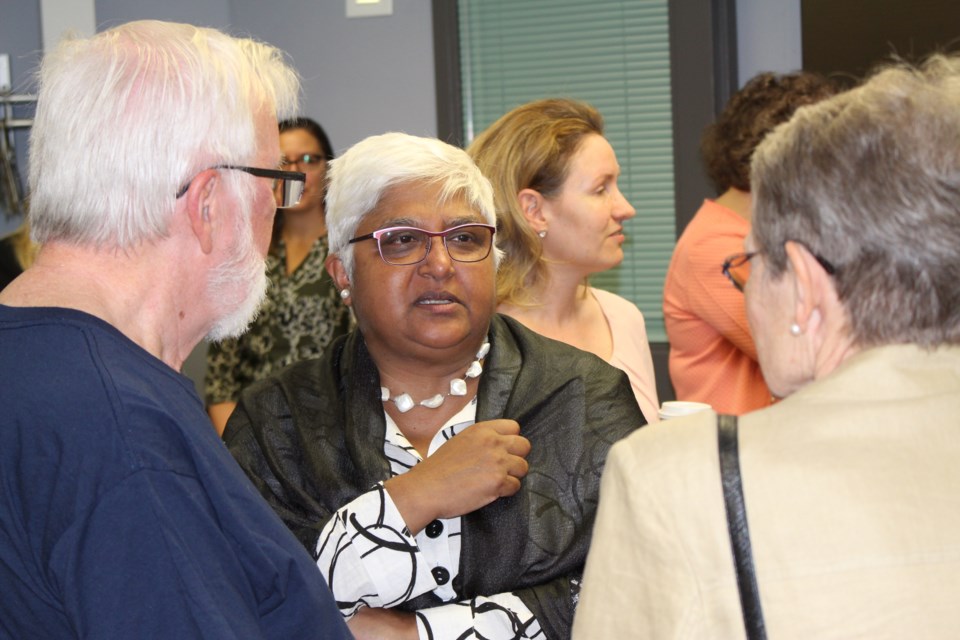The landscape of Ontario's medical schools is more niche-oriented than those outside of the health-care field may be aware, and Laurentian's Northern Ontario School of Medicine (NOSM) has its own unique place in that arena.
Dr. Sarita Verma has taken the helm as the dean, president and CEO at NOSM on a five-year term. She is the first female dean of the school, succeeding Dr. Roger Strasser, the school's founding dean and CEO.
Verma was the focal point of a meet and greet at the school on July 9, and while she admits she's still familiarizing herself with the city of Sudbury, her knowledge of NOSM is vast and goes back a number of years.
"What I knew about NOSM (before arriving) was fairly substantial because I've been at the table for the last 25 years. I was there at Queen's University as post-grad Dean when NOSM was born and watched the evolution," said Verma. "I met with the first post-grad dean, the first dean many times. NOSM is a relatively known entity, and I've been chair of the residency matching program nationally, so there's not too much that is a big surprise."
Verma is the former vice-president, Education at the Association of Faculties of Medicine of Canada (AFMC) and former associate vice-provost, Relations with Health Care Institutions and deputy dean of Medicine at the University of Toronto.
Before pursuing her medical degree at McMaster University (1991), Verma obtained a law degree from the University of Ottawa (1981), and, as mentioned, spent time at Queen's University.
Consistently ranked among the best medical schools in the country are University of Toronto, McMaster and Queen's, but Verma explained while the three are all excellent schools, they each fit a certain niche in the medical world.
"Queen's is kind of the Ivy League school, McMaster is the innovative medical school when it comes to new methods of learning, they're known for PBL (problem-based learning), and U of T is, of course, known as the discovery and major research engine of Canada, and they all have their own identities," said Verma.
"In Ontario it becomes a little more competitive ... University of Ottawa, they're the bilingual school; Western is the southwestern school that has some niche areas of research. What NOSM is known for and should be better known for is its commitment to community involvement. It's a completely different model of medical education. Most traditional forms of education rely on a heavy-duty classroom learning, small-group, book-learning experience. If you put a young person in front of a patient or a real person from almost Day 1 and give them the opportunity to develop those people skills, you're developing someone who has compassion and the ability to communicate and has the courage to deal with difficult issues."
Compared to some of the province's top medical schools, NOSM is still very much in its infant stages. Its first group of graduates are only 10 years removed from their schooling, but Verma said the opportunity to work in a smaller centre and at a smaller hospital such as Health Sciences North pushes doctors to think outside the box more often and employ all of their diagnostic skills.
"When you put someone in a smaller hospital or a community clinic, you've got a different kind of doctor, and that doctor is what NOSM is known for," said Verma. "That doctor is not just competent, but confident and has the courage to think outside the box. That's a whole new thing that NOSM is known for, but I would pit any one of those guys against a super sub-specialist in a big city and say they're going to be far more effective as a doctor."
NOSM's commitment to the community is something Verma continued to praise, stressing the value of looking beyond what could be seen as an assembly-line model at larger medical schools, where doctors are being churned out in large numbers but not staying in their own communities.
"Medical schools shouldn't just be in the production of health professionals that graduate. Yhere should be a link to those communities that you are part of," said Verma.
"The return on investment for that community, the linkage to that is to make sure that your graduates actually go into those areas of need. You don't just create graduates and say 'go do whatever you want' that's just factory output; what you have to do is create an environment in which those people who come from these communities go to these communities, and I think we're very successful in that regard, but we still have a way to go."
The strength of NOSM comes from its partnerships and having "everybody jumping into the pool" as Verma puts it.
"You need the combination — it's HSN, HSNRI, the City of Greater Sudbury, the Indigenous communities that surround us," she said. "It's very important to have partnerships with our Francophone communities. It's the Ministry of Health that has made a commitment to this institution."
"It's not just a medical school, it's a health human resource strategy and it's a corporation. What's unique about NOSM is it's a corporation with corporate values and metrics. We're going to be like Google and Apple and all of the great corporations that have led innovation, and that's what's going to distinguish us as a medical school."
